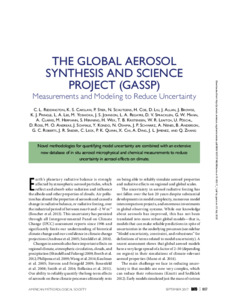REDDINGTON, C.L., CARSLAW, K.S., STIER, P., SCHUTGENS, N., COE, H., LIU, D., ALLAN, J., BROWSE, J., PRINGLE, K.J., LEE, Lindsay, YOSHIOKA, M., JOHNSON, J.S., REGAYRE, L.A., SPRACKLEN, D.V., MANN, G.W., CLARKE, A., HERMANN, M., HENNING, S., WEX, H., KRISTENSEN, T.B., LEAITCH, W.R., PÖSCHL, U., ROSE, D., ANDREAE, M.O., SCHMALE, J., KONDO, Y., OSHIMA, N., SCHWARZ, J.P., NENES, A., ANDERSON, B., ROBERTS, G.C., SNIDER, J.R., LECK, C., QUINN, P.K., CHI, X., DING, A., JIMENEZ, J.L. and ZHANG, Q.
(2017).
The global aerosol synthesis and science project (GASSP): Measurements and modeling to reduce uncertainty.
Bulletin of the American Meteorological Society, 98 (9), 1857-1877.
[Article]
Documents
26688:552251
![[thumbnail of Reddington2017.pdf]](https://shura.shu.ac.uk/26688/1.hassmallThumbnailVersion/Reddington2017.pdf)

Preview
Abstract
The largest uncertainty in the historical radiative forcing of climate is caused by changes in aerosol particles due to anthropogenic activity. Sophisticated aerosol microphysics processes have been included in many climate models in an effort to reduce the uncertainty. However, the models are very challenging to evaluate and constrain because they require extensive in situ measurements of the particle size distribution, number concentration, and chemical composition that are not available from global satellite observations. The Global Aerosol Synthesis and Science Project (GASSP) aims to improve the robustness of global aerosol models by combining new methodologies for quantifying model uncertainty, to create an extensive global dataset of aerosol in situ microphysical and chemical measurements, and to develop new ways to assess the uncertainty associated with comparing sparse point measurements with low-resolution models. GASSP has assembled over 45,000 hours of measurements from ships and aircraft as well as data from over 350 ground stations. The measurements have been harmonized into a standardized format that is easily used by modelers and nonspecialist users. Available measurements are extensive, but they are biased to polluted regions of the Northern Hemisphere, leaving large pristine regions and many continental areas poorly sampled. The aerosol radiative forcing uncertainty can be reduced using a rigorous model–data synthesis approach. Nevertheless, our research highlights significant remaining challenges because of the difficulty of constraining many interwoven model uncertainties simultaneously. Although the physical realism of global aerosol models still needs to be improved, the uncertainty in aerosol radiative forcing will be reduced most effectively by systematically and rigorously constraining the models using extensive syntheses of measurements.
Actions (login required)
 |
View Item |



 Tools
Tools Tools
Tools